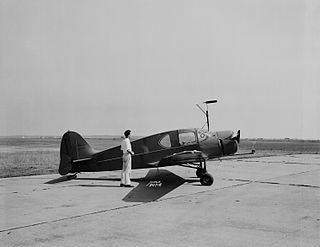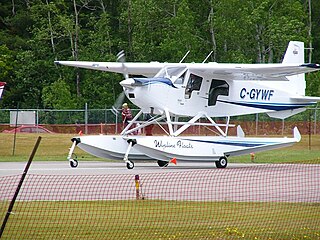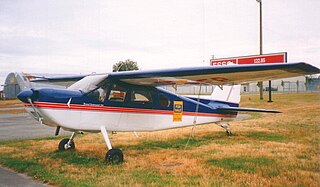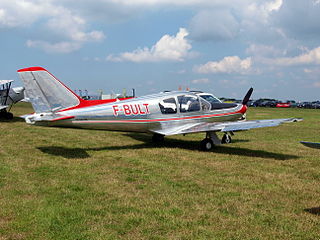Related Research Articles

The Piper PA-32 Cherokee Six is a series of single-engine, fixed landing gear, light aircraft manufactured in the United States by Piper Aircraft between 1965 and 2007.

The Helio Courier is a cantilever high-wing light STOL utility aircraft designed in 1949.

The Curtiss-Wright AT-9 Jeep is an American twin-engined advanced trainer aircraft used by the United States during World War II to bridge the gap between single-engined trainers and twin-engined combat aircraft. The AT-9 had a low-wing cantilever monoplane configuration, retractable landing gear and was powered by two Lycoming R-680-9 radial engines.

The Pacific Aerospace Corporation CT/4 Airtrainer series is an all-metal-construction, single-engine, two-place with side-by-side seating, fully aerobatic, piston-engined, basic training aircraft manufactured in Hamilton, New Zealand.

The Bellanca 14-7 Cruisair and its successors were a family of single-engined light aircraft manufactured in the United States from the mid-1930s onwards.

The Berkut 360 is a tandem-seating, two-seat homebuilt canard aircraft with pusher configuration and retractable landing gear, built primarily of carbon fiber and fiberglass.

The Velocity XL is an American amateur-built aircraft, produced by Velocity, Inc. It is an enlarged version of their Velocity SE canard pusher design.

The Beechcraft Queen Air is a twin-engined light aircraft produced by Beechcraft in numerous versions from 1960 to 1978. Based upon the Twin Bonanza, with which it shared key components such as wings, engines, and tail surfaces, it had a larger fuselage, and served as the basis for the highly successful King Air series of turboprop aircraft. Its primary uses have been as a private aircraft, utility, and small commuter airliner. Production ran for 17 years.

The Bellanca Viking and Super Viking are a series of single-engine, four-seat, high performance, retractable gear aircraft manufactured in the USA during the 1960s and 1970s. The aircraft developed through modifications of classic designs by the aviation pioneer Giuseppe Bellanca. A total of 1,356 Vikings have been produced with most production between 1968 and 1975.

The PZL-105 Flaming (flamingo) is a Polish short-takeoff-and-landing (STOL) utility aircraft designed by PZL "Warszawa-Okęcie". It remained a prototype.

The Piper PA-36 Pawnee Brave is a 1970s American single-engined, low-wing, propeller-driven agricultural plane built by Piper Aircraft.

The Found FBA-2 is a 1960s Canadian four/five-seat cabin monoplane that was produced by Found Aircraft.

The Found Centennial 100 is a Canadian six-seat cabin monoplane produced by Found Brothers Aviation.

The Piper Aerostar is an American twin-engined propeller-driven executive or light transport aircraft, designed by Ted R. Smith. It was originally built by Ted Smith Aircraft Company, but the design was acquired in 1978 by the Piper Aircraft Corporation, which continued production of the aircraft as the PA-60.

The Robin HR100 is a French four-seat light monoplane, designed by Chris Heintz and built by Avions Pierre Robin as metal-winged version of the Robin DR253 Regent.

The Procaer F.15 Picchio is an Italian-designed light utility aircraft built by Procaer.

The Rockwell Commander 112 is an American four-seat single-engined general aviation aircraft designed and built by North American Rockwell starting in 1972. In 1976, they introduced the turbocharged version 112TC and mounting a larger engine with other minor improvements they introduced the Rockwell Commander 114. A total of approximately 1,300 examples of all models were produced before the production line shut down in 1980. In 1981, the type certificate owner was Gulfstream Aerospace, but that company had no interest in single-engine piston production.
The Jurca MJ-51 Sperocco is a plans-built two-seat tandem aerobatic aircraft derived from the Jurca MJ-5 Sirocco.
The Aristocraft II was a six-place homebuilt aircraft designed by Terrence O'Neill.

The Vertical Hummingbird is an American helicopter, produced by Vertical Aviation Technologies of Sanford, Florida that was introduced in 1991. The aircraft is supplied as a kit for amateur construction.
References
- ↑ "Philippine Aerospace Industry". globalsecurity.org. April 3, 2012. Retrieved January 21, 2018.
- ↑ "FAILED DREAMS - The Defiant and Hummingbird Projects". timawa.net. Archived from the original on 9 February 2004. Retrieved 7 March 2024.
- ↑ "The Phil. Aerospace Dev't Corporation & The Indigenous Aircraft Revival". Pitz Defense Analysis. 27 September 2016. Archived from the original on 7 March 2024. Retrieved 7 March 2024.
- 1 2 3 4 Ferreras, Ernesto Jr. "The Making of the Defiant 300". aeroengineer101.blogspot.com. Archived from the original on March 7, 2024. Retrieved January 21, 2018.
- ↑ "gulftoday.ae | Philippines to close aerospace agency for inactivity". 2017-12-28. Archived from the original on 2017-12-28. Retrieved 2024-03-07.
- ↑ Banzon, Jojo (January 1, 2014). "Philippine Aerospace R&D, Engineering and Manufacturing History". scribd.com. Archived from the original on March 7, 2024. Retrieved January 27, 2018.
- ↑ Lambert, Mark, ed. (1990). Jane's All The World's Aircraft 1990–91. Coulsdon, UK: Jane's Defence Data. p. 191. ISBN 0-7106-0908-6.